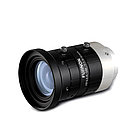Fujinon Anti-Shock & Vibration design offers reliable performance and image quality under strong acceleration and vibration

Photo by Fujifilm (EUROPE) GmbH
Industrial imaging systems are frequently subject to strong accelerations, shocks, and vibrations. This is especially true for mobile systems, like robot-guided 3D scanners, but also for fixed installations. Fujifilm has investigated the impact of shocks and vibrations on industrial fixed focal lenses via a dedicated test procedure. In many cases, the procedure leads to a significant reduction of the resolution and to a shift of the optical axis. However, the intensity of the effects depends heavily on the mechanical design of a camera lens – a widely underestimated aspect at the selection of fixed focal lenses.
Modern robot arms are so powerful they can move major loads with a multiple of the gravitational acceleration (unit G, 1 G = 9.81 m/s²). Robot-guided machine vision systems, as they are used with welding and assembly robots as well as with 3D scanning stations, need to withstand such accelerations. Additionally, they are exposed to the vibrations at the tip of the robot arms just like camera-lens setups at large machines with rotating elements, e.g. in large offset printing systems.
Most industrial machine vision solutions utilize industrial cameras and c-mount lenses with fixed focal length, which need to provide constant image quality irrespective of harsh conditions. Therefore, Fujifilm has developed a testing procedure for such lenses to measure their robustness against shocks and vibrations: At first, 10 G shocks impact the lenses from 6 different directions orthogonal to the optical axis. Next, a special vibrating table exposes the lenses to various sinusoidal vibrations according to IEC 60068-2-6 (up to 500 Hz and 100 m/s²). Finally, the shock test is repeated.
The results show a shift in the optical axis of a conventional lens by up to 26 µm which corresponds to approx. 7 pixels at Sony Pregius sensors of the second generation. Their resolution power, measured using a contrast chart, deteriorates dramatically (see false color rendering). For most machine vision applications, where fast accelerations and strong vibrations may occur, these lenses are not suitable. On the other hand, all lenses of the Fujinon HF-12M series, as well as the lenses of the HF-5M series with 6 and 50 mm focal length, withstand the shocks and vibrations showing a shift of the optical axis of just between 4 and 10 µm.
This is enabled by the Fujinon Anti-Shock & Vibration design, an elastic and patent pending fixation of the internal lens arrangement. At conventional camera objectives, the lenses are fixed with adhesives, which does not withstand shocks and vibrations plus it is sensitive to changes in humidity and temperature. The Anti-Shock & Vibration design of the Fujinon lenses, however, minimizes the dependency on adhesives and ensures a constant performance and image quality in the long run.
Beyond the optical format, resolution power, and focal length, developers of mechanically stressed imaging systems should consider the robustness of their camera objectives against shocks and vibrations.
For more information, please visit http://www.fujifilm.eu/fujinon.
News Categories
- » NEWS HOME
- » Automation & Robotics
- » Industry 4.0
- » Material Handling
- » Sensors
- » Quality & Testing
- » Machine Vision
- » Laser & Optics
- » Metalworking
- » Motion Control & Drives
- » Hydraulics & Pneumatics
- » Process Industry
- » Renewable Energy
- » Agriculture
- » Home & Office Furniture
- » Environmental Tech

